
Tired of dropped calls, slow speeds, no bars, or poor reception?
Maybe it’s time to switch carriers.
Switching to a new provider can give you a better signal, faster speeds, and more reliable call performance.
However, cell phone coverage varies a LOT by location, and there’s is no point in switching cell phone carriers if you’ll never have service, right?
That’s why in this article I am covering exactly how to tell which carrier has the best coverage in your area.
How To Tell Which Cell Phone Carrier Has Best Coverage In Your Area
First, when we are talking about what cell phone carrier has the best coverage, what we are really talking about is what network has the best coverage.
Here in the United States, there are three major networks: Verizon, AT&T, and T-Mobile.
And it turns out that ALL wireless carriers will use one of these three networks to provide coverage.
This includes those more affordable prepaid carriers you may have heard about, like Mint Mobile, US Mobile, Cricket Wireless, Metro by T-Mobile, Visible, and many others.
Here’s an overview of the three major networks, their network coverage, and their data speeds:
Verizon’s Network

Verizon’s network is still one of the best networks here in the United States. It has great overall performance, great coverage, and great reliability.
RootMetrics ranked Verizon as tied for #1 overall, #2 in reliability, #1 in accessibility, #2 in speed, #2 in data reliability, and tied for #1 in both call reliability and text reliability.
OpenSignal ranked Verizon as having the best 4G coverage experience, best 5G games experience, and best 5G voice app experience.
Ookla ranked Verizon’s network as tied for #1 in 5G consistency, and #2 in median download speeds, 5G median download speeds, and consistency.
And PCMag’s Best Mobile Networks test for 2022 clocked Verizon as having the fastest maximum download speeds at 3,891Mbps. Verizon’s network ranked as the second-fastest overall.
According to Verizon’s website, their LTE network covers over 2.68 million square miles and over 327 million people.
That’s over 99% of the U.S. population.
Verizon’s 5G coverage is a bit smaller, but it’s expanding rapidly.
Verizon classifies its 5G network in two categories:
- Verizon 5G Nationwide
- Verizon 5G Ultra Wideband
Verizon 5G Nationwide
Verizon’s 5G Nationwide network is using a technology called DSS, or Dynamic Spectrum Sharing.
Basically, Verizon is broadcasting 5G signal on existing 4G LTE frequencies, and these two technologies share the available bandwidth.
The bandwidth allocated to 5G and 4G LTE can change rapidly to meet the demand of 5G phones vs LTE phones in a given area at a given time.
Your speeds on Verizon 5G Nationwide won’t be terribly fast. Instead, you’ll get about the same performance as on LTE. That’s because both technologies are using the same frequencies.
The frequencies Verizon is using for their 5G Nationwide network are classified as “low-band 5G” frequencies. Verizon’s low-band 5G bands are n5 (850MHz), n2 (1900MHz), and n66 (1700-2100MHz).
Low-band 5G frequencies are known for traveling far, but providing generally slower data speeds.
If you see Verizon 5G in your status bar, odds are you’re connected to their 5G Nationwide network. The signal travels far, and it’s especially more common in rural areas.

Verizon 5G Ultra Wideband
To get faster speeds on Verizon, you’ll need to connect to their 5G Ultra Wideband network. This is using new frequencies classified as mid-band and high-band 5G. Sometimes high-band 5G is called “mmWave” 5G because the wavelengths of the spectrum are measured in millimeters.
The new mid-band and mmWave 5G frequencies allow for tremendously more throughput and faster data speeds.
To tell when you’re connected to Verizon’s 5G Ultra Wideband network, you’ll see a small “5G UW” icon in your status bar. You’ll also need a compatible 5G phone with the right 5G antenna bands.
Verizon's 5G Ultra Wideband network uses the following 5G bands and frequencies: n77 (3700 MHz), n261 (28 GHz) and n260 (39 GHz).
Speeds on Verizon’s 5G Ultra Wideband network range from about 300Mbps to over 4Gbps.
5G Ultra Wideband is currently available in over 1,700 cities, and it covers over 100 million people.
By the end of 2022, Verizon will cover 175 million people with their new 5G Ultra Wideband network.
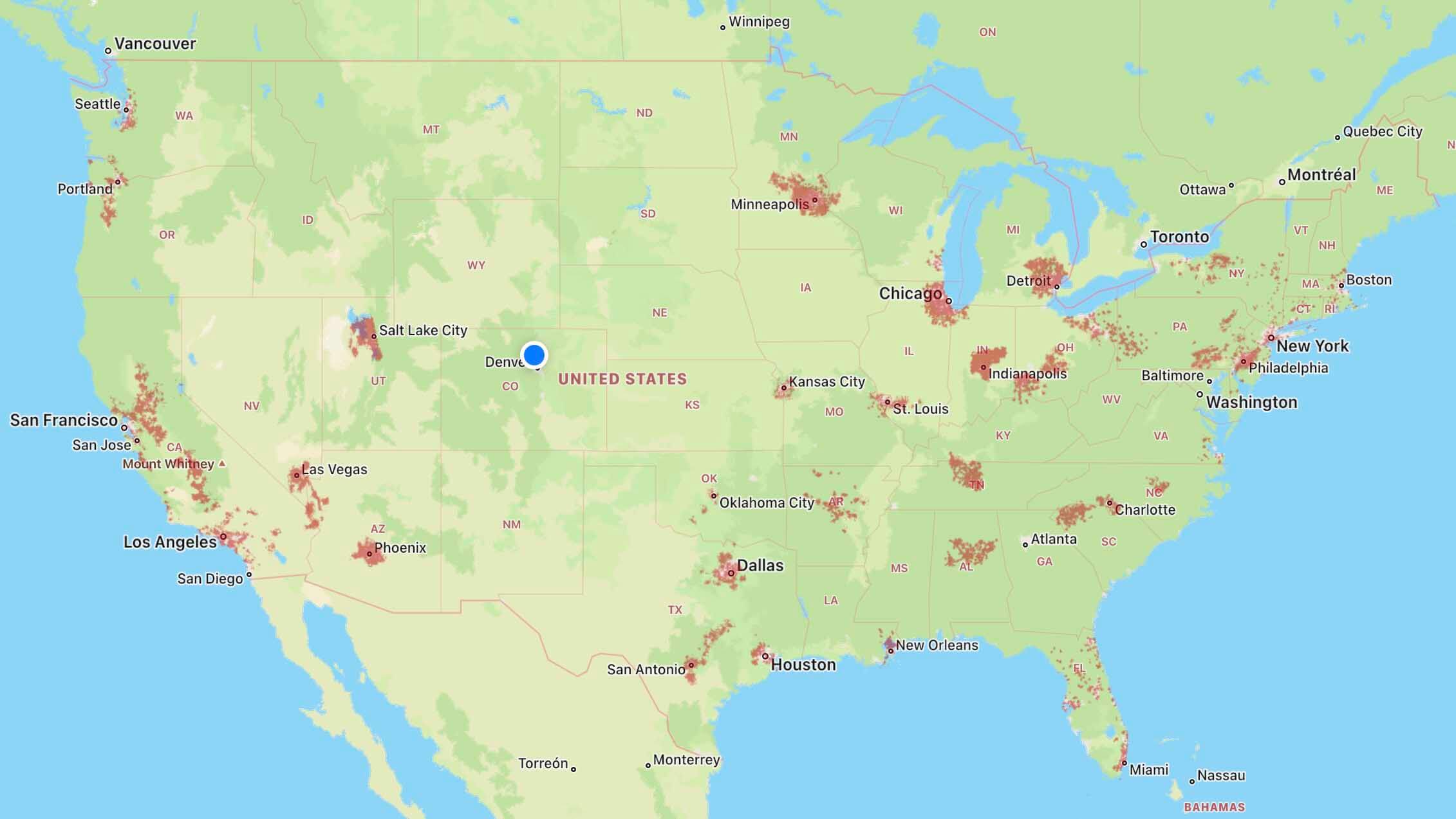

Check Verizon Coverage
You can check Verizon coverage in your area using Verizon’s coverage map.
Additionally, you can also sign up for a month of service on US Mobile, an MVNO that uses Verizon for coverage, to test out Verizon’s coverage and data speeds in your area.
AT&T’s Network

AT&T’s network has great coverage and superb consistency. It covers 2.7 million square miles and over 99% of the U.S. population.
RootMetrics ranked AT&T as tied for #1 overall, #1 in reliability, #3 in accessibility, #1 in speed, #1 in data reliability, and tied #1 in call reliability and text reliability.
OpenSignal ranked AT&T as tied for having the best games experience.
Ookla ranked AT&T as #2 in 5G availability.
And PCMag ranked AT&T third overall in their Fastest Mobile Networks Test for 2022.
AT&T’s network is divided into three main categories:
- AT&T’s LTE network
- AT&T’s low-band 5G network
- AT&T’s 5G+ network
AT&T’s LTE Network
AT&T’s LTE network is what gives AT&T a strong coverage footprint. It’s the foundation for the 2.7 million square miles that AT&T covers, and it reaches out into the rural parts of America.
You can tell you’re connected to AT&T’s LTE network when your phone says “LTE” in the status bar, or sometimes “5Ge”.
Yes, AT&T has branded part of its LTE network as “5Ge,” and yes this is intentionally meant to confuse people.
5Ge stands for “5G Evolution.” AT&T says 5Ge was an evolution of their LTE network.
While it’s not true 5G, AT&T 5Ge still does typically offer great speeds and performance.
AT&T’s LTE (and 5Ge) bands are 2 (1900 MHz), 4 (1700/2100 MHz), 5 (850 MHz), 12 (700MHz), 14 (700 MHz), 17 (700 MHz), 29 (700 MHz), 30 (2300 MHz), and 66 (1700/2100 MHz).
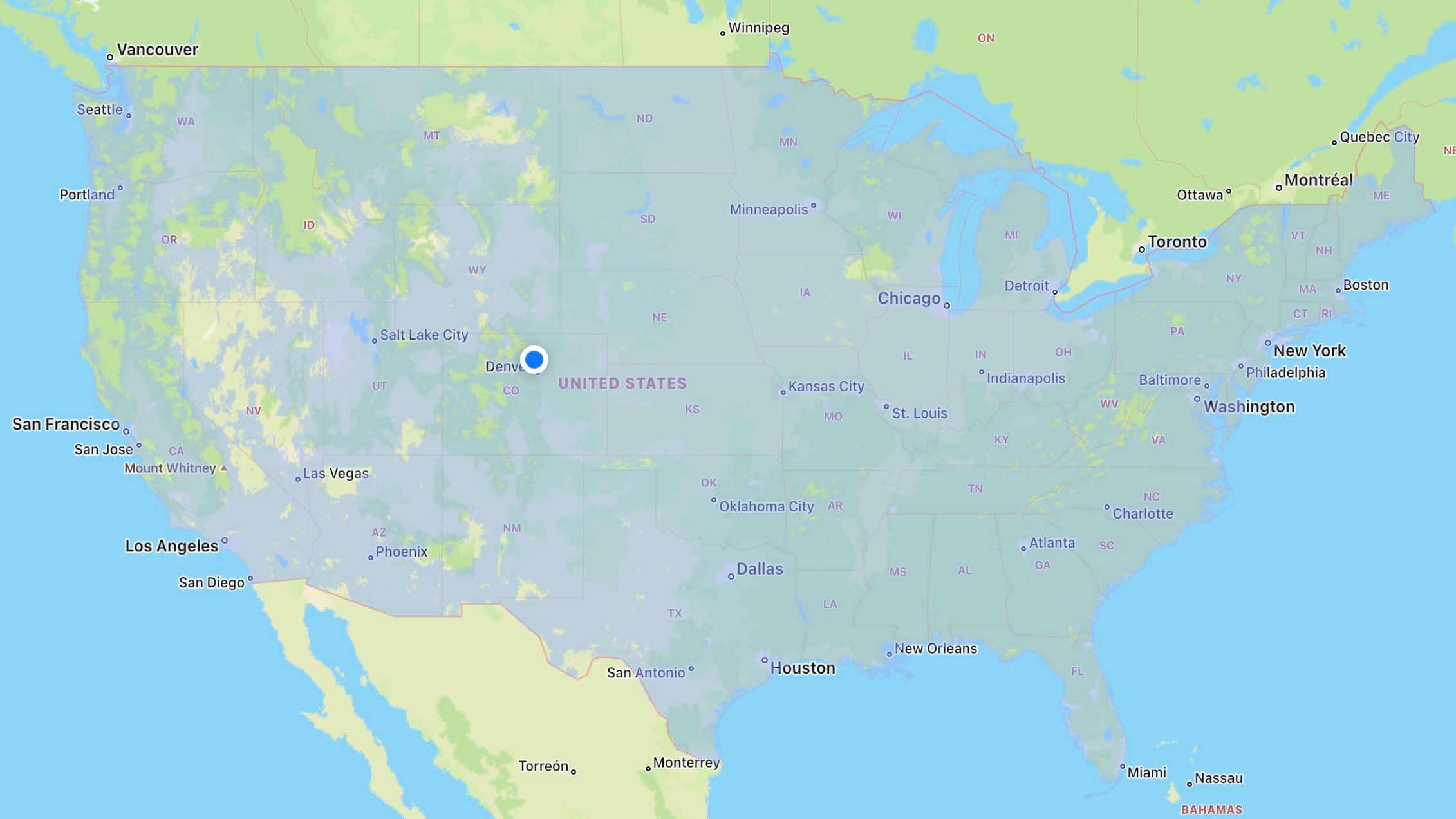
AT&T’s Low-Band 5G Network
AT&T’s low-band 5G network is using a technology called DSS (dynamic spectrum sharing).
It allows AT&T to broadcast 5G on their existing 4G LTE spectrum.
The bandwidth allocated to 5G and 4G LTE can change dynamically depending on how many 5G and LTE users there are at any given time.
Using DSS allowed AT&T to rapidly roll out their low-band 5G network and quickly cover a large number of people.
AT&T’s low-band 5G network covers over 255 million people in over 18,000 cities and towns across the U.S.
Unfortunately, low-band 5G speeds are nothing to write home about. You’ll typically see speeds about fast as LTE speeds.
The only improvements you’ll see, if any, are typically lower ping times and slightly faster upload speeds.
AT&T is currently just using band n5 (850 MHz) for its low-band 5G network.

AT&T’s 5G+ Network
AT&T’s 5G+ network uses mid-band and mmWave 5G frequencies to provide exceptionally fast data speeds to its customers.
The mid-band spectrum is C-band, which AT&T spent over $23.4 billion to acquire. C band is band n77 (3700 MHz), and AT&T currently has it deployed in a measly 8 cities (compared to Verizon’s 1,700 cities).
The reason AT&T is taking so long to deploy C-band is because they are waiting on special antennas that can broadcast C-band frequencies along with another chunk of frequencies called the Andromeda spectrum (3.45 GHz) that AT&T spent over $9 billion on in FCC auction 110.
The new antennas AT&T needs should be more readily available by mid summer 2022, and I expect we’ll see AT&T dramatically ramp up the rollout of its mid-band 5G network towards the end of 2022.
In terms of the mmWave frequencies, AT&T is using band n260 (39 GHz). AT&T has rolled out mmWave in just over 40 cities and 40 stadiums and venues.
Compared to Verizon and T-Mobile, AT&T’s 5G rollout has been going much slower.
Thankfully, AT&T’s LTE/5Ge network already provided great coverage and fast data speeds.

Check AT&T Coverage
Check AT&T coverage in your area by using AT&T’s coverage map.
Additionally, you can also sign up for a month of service from Boost Mobile at my.boostmobile.com to see exactly how AT&T’s coverage and data speeds are in your area. Boost Mobile is an MVNO that uses AT&T for coverage.
T-Mobile’s Network

T-Mobile’s network is the most improved network of the bunch. And T-Mobile needed it.
Historically T-Mobile had fast speeds, but only in certain metropolitan areas.
Today, after the Sprint-T-Mobile merger, T-Mobile has become a leader in deploying 5G, drastically improving their coverage footprint, and providing some of the fastest data speeds.
However, despite the improvements, T-Mobile may still be better in certain areas than in others. The rankings from the different reports vary quite a bit here.
RootMetrics ranked T-Mobile #3 pretty much across the board. T-Mobile ranked #3 for reliability, speed, data reliability, call reliability, text reliability, and #3 overall. Only in the accessibility category did T-Mobile secure a #2 spot.
For OpenSignal though, it’s an entirely different story. They ranked T-Mobile as the #1 winner for voice app experience, download speed experience, upload speed experience, 4G availability, 5G availability, 5G reach, 5G download speed, and 5G upload speed.
Ookla also ranked T-Mobile highly. T-Mobile had the fastest median download speeds of 117.83 Mbps, tied for the best latency at 31ms, had the highest consistency score of 88.3%, had the fastest 5G performance at 191.12 Mbps, had the greatest 5G availability at 65%, and had the tied for the highest 5G consistency with a score of 79.9%.
Finally, PCMag crowned T-Mobile as the overall winner in their Best Mobile Networks test for 2022. That’s because T-Mobile averaged 264.4 Mbps down in PCMag’s extensive testing, while Verizon and AT&T averaged 156.8 Mbps and 79.0 Mbps down respectively.
T-Mobile classifies their network in three categories:
- T-Mobile LTE
- T-Mobile Extended Range 5G
- T-Mobile Ultra Capacity 5G
T-Mobile’s LTE Network
T-Mobile’s LTE network covers 99% of Americans. However, compared to Verizon and AT&T’s LTE networks, it’s still the weakest of the bunch.
RootMetrics’ State of Mobile Networks report for the second half of 2019 had T-Mobile squarely in 3rd place.
That’s why T-Mobile has put so much effort into rapidly building out their 5G network––they want to be a leader in the 5G era (instead of being left behind like they were in the LTE era).
Like with all networks, T-Mobile’s LTE network coverage and performance vary a lot by location. With coverage of 99% of the U.S. population, T-Mobile’s LTE network will get the job done for a lot of people.
But the real speed, performance, and coverage improvements come with T-Mobile’s 5G networks.
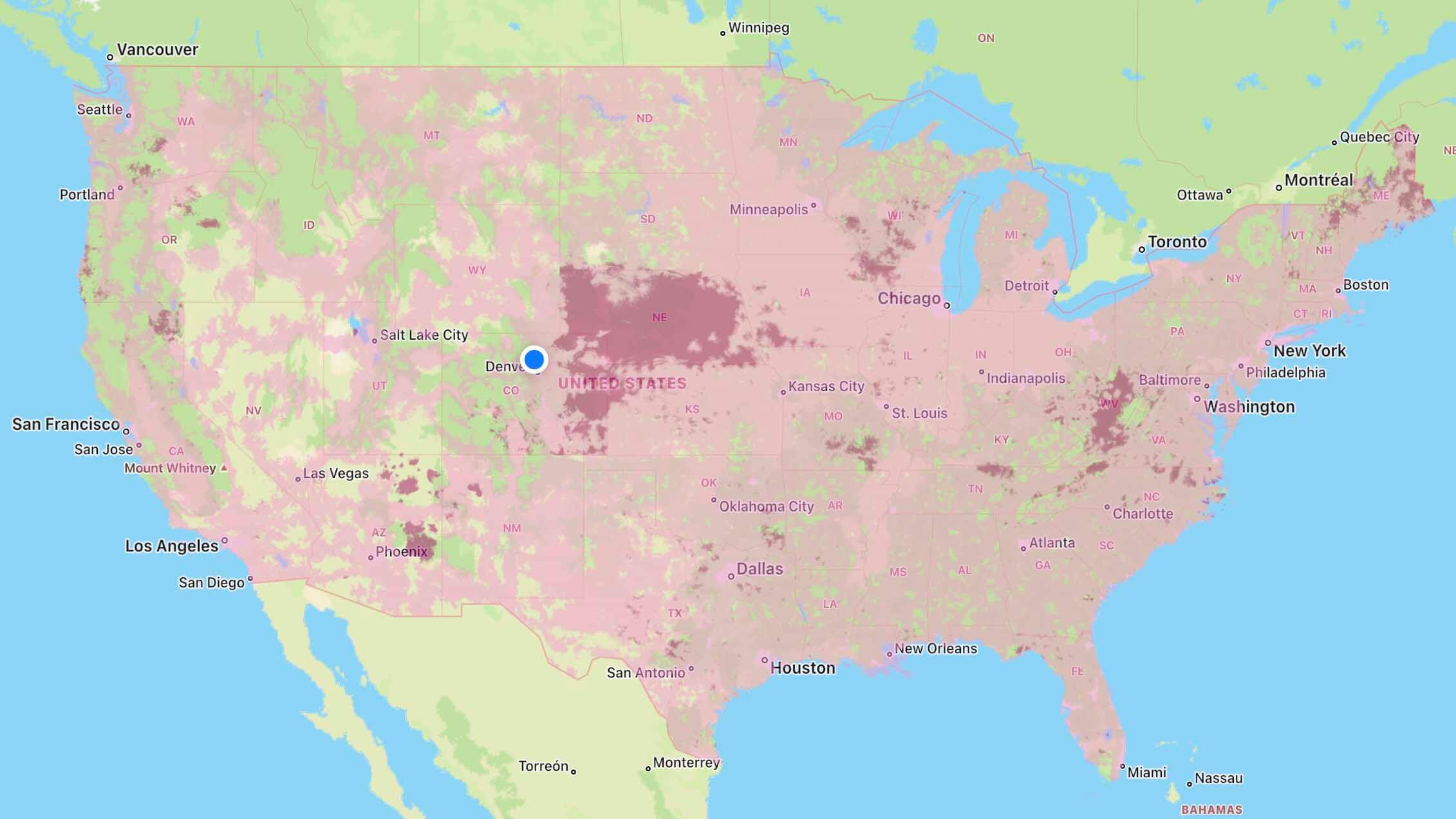
T-Mobile’s Extended Range 5G Network
T-Mobile’s Extended Range 5G network uses low-band 5G frequencies. Low-band 5G is known for traveling far distances and providing a greater coverage footprint than mid-band or mmWave 5G.
T-Mobile’s 5G network covers 1.7 million square miles and over 305 million people (about 92% of the U.S. population), and the use of low-band 5G is a big part of how T-Mobile is able to cover so many people.
Powering the Extended Range 5G network is 5G band n71 (600 MHz). Notice how band n71 operates at 600 MHz, much lower than the 850 MHz AT&T and Verizon are using for 5G band n5. The low 600 MHz frequency helps T-Mobile’s low-band network travel extra far.
BUT, low-band 5G doesn’t offer those jaw-dropping ultra-fast 5G speeds. Instead, you’ll see about the same performance as LTE, or slightly faster speeds.

T-Mobile’s Ultra Capacity 5G Network
T-Mobile’s Ultra Capacity 5G network is where the real magic happens. This is where you’ll see impressive 5G speeds ranging from 200-600Mbps, and sometimes higher.
And what’s even more impressive is that T-Mobile already covers 200 million people with their Ultra Capacity 5G network. That’s about double the number of people Verizon covers with their 5G Ultra Wideband network.
The secret sauce to Ultra Capacity 5G is a 5G band called n41.
Band n41 is the antenna band T-Mobile got by merging with Sprint, and it operates at 2.5 GHz. This is in the spectrum sweet spot of providing fast speeds and great coverage.
You can tell your phone is connected to the Ultra Capacity 5G network when you see a “5G UC” icon in your status bar. You’ll also need a phone with band n41 support.
Additionally, T-Mobile also uses mmWave as part of its Ultra Capacity 5G network. T-Mobile’s mmWave frequencies are n261 (28 GHz) and n260 (39 GHz).
However, T-Mobile mmWave is really hard to find. That’s because it’s only in six cities. And it doesn’t look like T-Mobile is going to improve mmWave coverage anytime soon.
It’s almost as if T-Mobile gave up on mmWave.
Thankfully T-Mobile didn’t give up on n41, and n41 has been doing an exceptional job providing fast 5G speeds across the country.

Check T-Mobile Coverage
You can check to see T-Mobile coverage in your area by using T-Mobile’s coverage maps.
Additionally, you could also take advantage of T-Mobile’s free trial
How To Check Which Network Is Best In Your Area
Okay, so how do you check which network in the best in your area?
Let’s cover three different resources you can use for checking coverage, data speeds, and network performance in your specific area:
- CoverageCritic
- Ookla Speedtest
- RootMetrics
CoverageCritic
First up is one of my favorite sites: CoverageCritic.
This was actually built by my friend Chris, and he made it super simple.
All you do is enter your ZIP code, and his site will automatically tell you what network has the best coverage in your area.
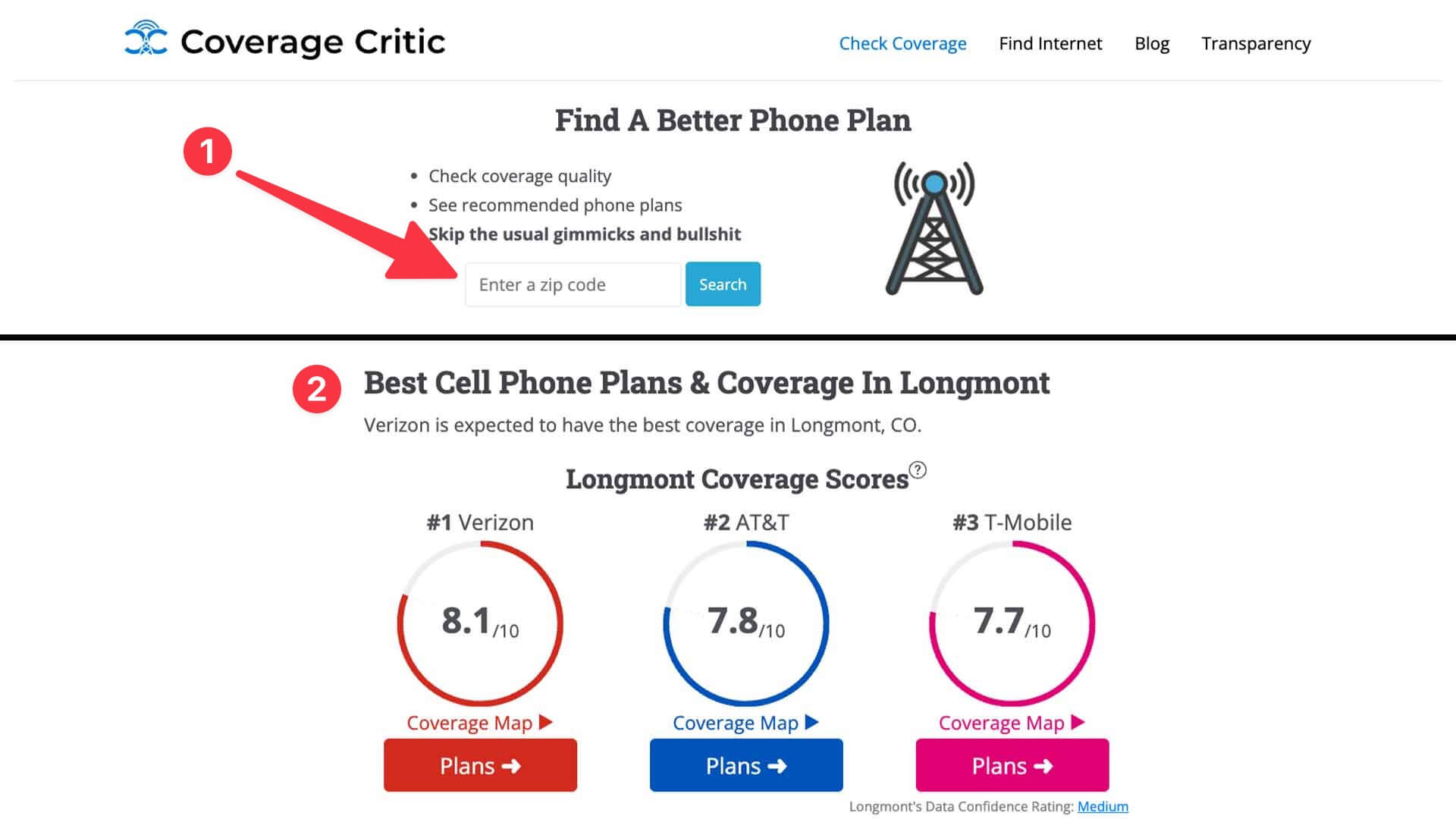
It’s an awesome tool for getting started.
One thing you’ll notice is that while CoverageCritic tells you the best coverage, it doesn’t indicate the fastest data speeds.
So let’s move on to a resource that is the champion of data speeds: Ookla Speedtest.
Ookla Speedtest
Ookla, if you’re not familiar with it, makes that iconic speed test app you always see that helps people check data speeds and diagnose network issues.
As a result of making a speed test app, Ookla collects a LOT of speed test data.
What do they do with all this data, you ask?
They make reports and do industry analysis.
One such report is the United States Median Speed report. This lists both regional speeds and city speeds and can be helpful for identifying the fastest provider in your area.
- Regional Speeds: Lists all 50 U.S. states along with the District of Columbia and tells you the fastest provider in each state based on median download speeds
- City Speeds: Tells you the provider with the fastest speeds in the top 100 U.S. cities

Ookla LTE/5G Cell Phone Coverage Maps
Something that is useful for everyone though is Ookla’s new coverage maps.
Right now the coverage maps are only available in the mobile application, so you’ll have to download the Ookla app from the Apple App Store or Google Play Store.
Once you have it installed, you can go to the maps section to browse network coverage in your specific area.
The more you zoom in, the more accurate the data is. The different colors represent 5G, LTE, 2G/3G, and no coverage.
It’s a pretty awesome tool for checking coverage in your area. As a bonus, anytime you run a cellular data speed test using the Ookla app, you’re contributing data to the coverage map to improve results for everyone.
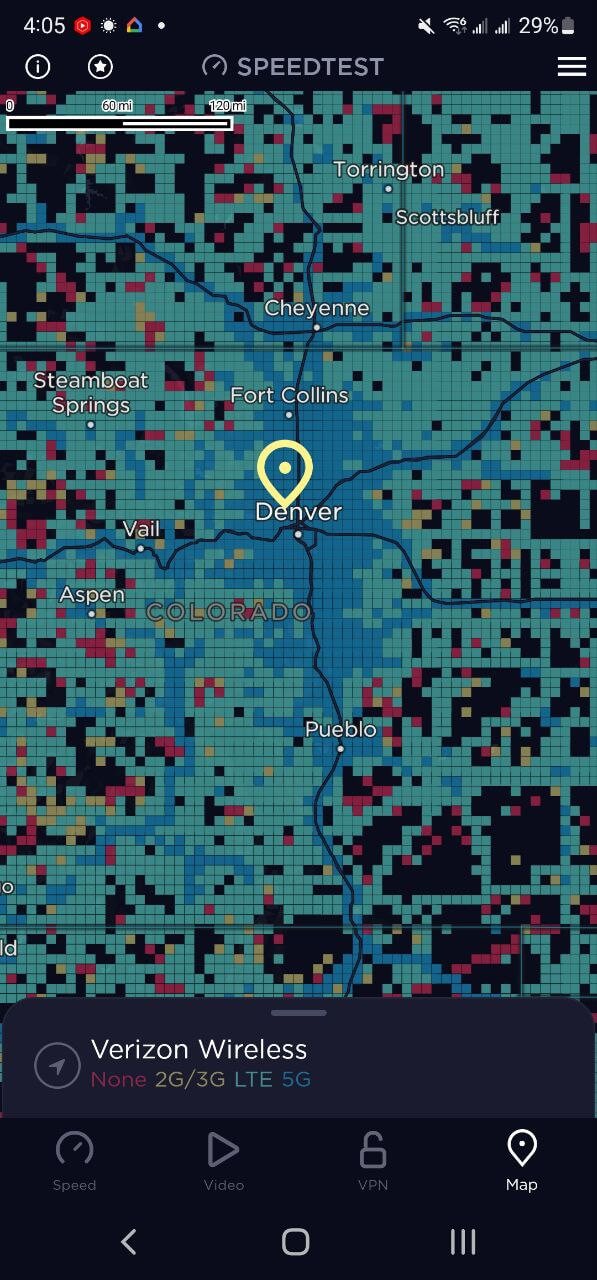
RootMetrics
The third resource I want to show you is RootMetrics.
RootMetrics uses its own data to build reports for the top 125 cities in the United States, and you get way more data here.
You can see the winner for overall performance, network reliability, network accessibility, network speed, data performance, call performance, and text performance.
You can even see the testing period, the testing area, how many miles were driven, and the number of indoor locations tested.
If you wanted, you could also pop into the State/National view to get a better idea of the best network in each specific state.
How To Test Network Coverage And Data Speeds For Yourself (For Cheap)
CoverageCritic, Ookla Speedtest, and RootMetrics are three great resources for checking coverage and data speeds in your area before you switch providers.
But, with all that said, there is no better way to check coverage than to test it for yourself.
So how do you test coverage? Here are the best ways to try Verizon, AT&T, and T-Mobile for the cheapest prices possible.
How To Test Verizon Coverage
To try Verizon, I recommend you sign up for one month of US Mobile service.
US Mobile is an MVNO that uses Verizon for coverage. Their 12GB plan is just $20 per month, and it’s a perfect option for testing out the network.
All you need to do is order a SIM kit (and use code FREEKIT to make sure you get it for free), activate on the plan you want with a new number, and then test the network performance in your area by running data speed tests and making a few test phone calls.
How To Test AT&T Coverage
Next, to try AT&T I recommend a plan from Boost Mobile.
Boost’s $25 5GB plan is affordable, and it’ll give you enough data to run some speed tests and test out the AT&T network.
Plus, Boost doesn’t have any activation fees when you order online, and they give you the SIM card for free.
Just make sure you sign up at my.boostmobile.com. This is a special website Boost set up where all activations are on the AT&T network.
If you accidentally activate on the regular Boost Mobile website, then you’ll be activating on the T-Mobile website.
Use this link to make sure you’re getting a plan on AT&T.
How To Test T-Mobile Coverage
To try T-Mobile for the cheapest price possible, you’re going to want to use T-Mobile’s free trial.
This is a 30-day plan that’s completely free and gives you 30GB of high-speed data to test out the T-Mobile network.
If you have an iPhone, activating the plan is as simple as downloading the app and installing an eSIM.
Watch my video to see how it’s done:
If you don’t have an iPhone, T-Mobile will ship out a free hotspot device that you can tether to run data speed tests. This may impact performance a little bit, but it should still give you a good idea of T-Mobile's performance and coverage in your area.
That’s how to tell what network provides the best coverage and fastest data speeds in your area, and I hope that’s helpful!

